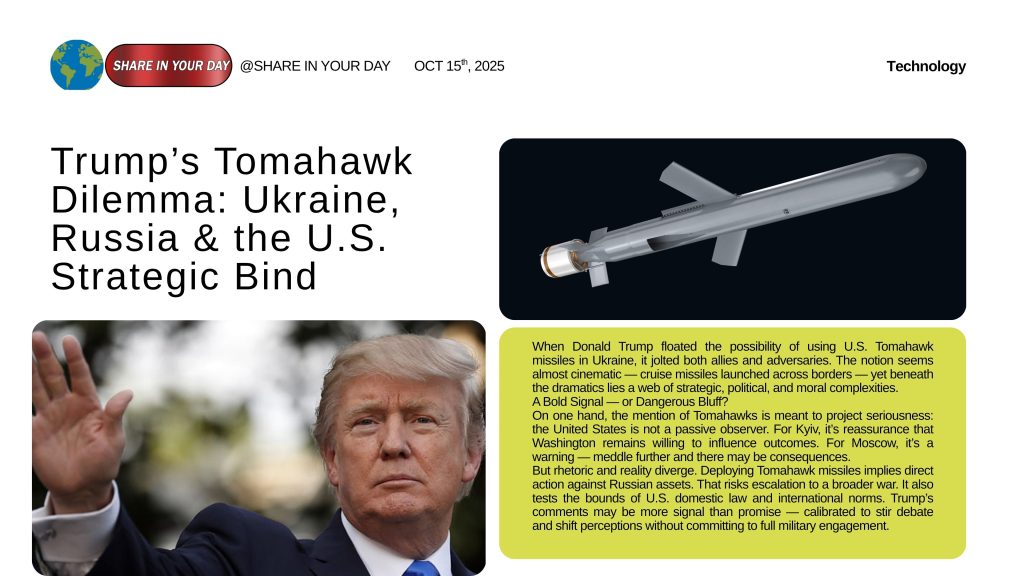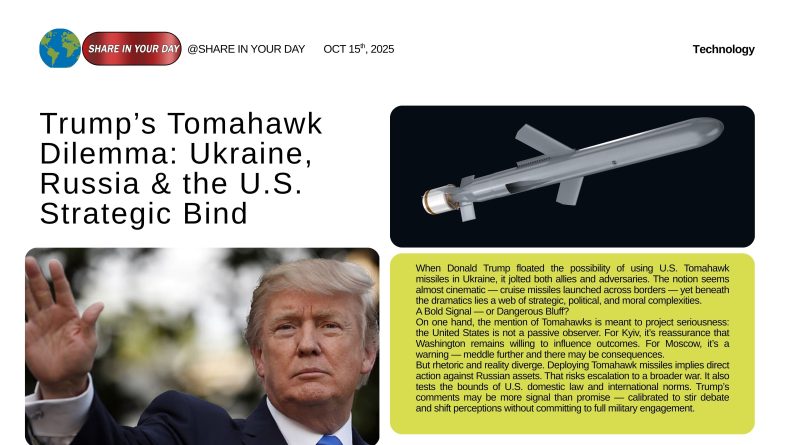Trump’s Tomahawk Dilemma: Ukraine, Russia & the U.S. Strategic Bind
When Donald Trump floated the possibility of using U.S. Tomahawk missiles in Ukraine, it jolted both allies and adversaries. The notion seems almost cinematic — cruise missiles launched across borders — yet beneath the dramatics lies a web of strategic, political, and moral complexities.
A Bold Signal — or Dangerous Bluff?
On one hand, the mention of Tomahawks is meant to project seriousness: the United States is not a passive observer. For Kyiv, it’s reassurance that Washington remains willing to influence outcomes. For Moscow, it’s a warning — meddle further and there may be consequences.
But rhetoric and reality diverge. Deploying Tomahawk missiles implies direct action against Russian assets. That risks escalation to a broader war. It also tests the bounds of U.S. domestic law and international norms. Trump’s comments may be more signal than promise — calibrated to stir debate and shift perceptions without committing to full military engagement.
The Strategic Tightrope
- Escalation Risk
Every missile launched would risk retaliation. Russia holds vast conventional and nuclear capabilities. A single misstep could spin into uncontrolled crisis. - Alliance Cohesion
Europe is wary. Many NATO partners want strong support for Ukraine — but not at the cost of full-scale war with Russia. Moscow could exploit divisions, testing which nations will stand firm. - Legal & Political Constraints
The U.S. Congress has restrictive mandates on direct military interventions. A President cannot simply order missile strikes without either congressional authorization or a compelling legal justification. - Credibility & Deterrence
If Trump or any U.S. leader threatens force but fails to follow through, credibility suffers. That weakens deterrence — not just regarding Russia but for future conflicts. Conversely, a striking show of force that succeeds may reinforce U.S. resolve in global disputes.
The Domestic Political Angle
Within U.S. politics, making aggressive foreign policy promises energizes a base that favors strength and confrontation. It also differentiates Trump from more cautious voices. But the rhetorical upside must grapple with the risk of being held accountable if escalation follows.
Media and opposition will demand clarity: Where, when, and against whom? Vague threats can backfire — generating fear without clear governance.
The Russian Reaction
From Moscow’s lens, any Tomahawk deployment is an affront — an act of war by proxy or direct intervention. Russia could:
- Escalate in Ukraine.
- Hit U.S. assets or interests elsewhere.
- Increase cyberattacks or asymmetric retaliation in Europe.
They also may respond diplomatically — using global forums, alliances, and information warfare.
What’s the Middle Path?
Given the risks, the U.S. may prefer calibrated steps:
- Intelligence & surveillance operations to aid Ukraine without overt strikes.
- Targeted, limited strikes with strict conditions and clear objectives, reducing the chance of uncontrolled escalation.
- Diplomatic backing and sanctions as force multipliers.
- Joint operations with allies, to share burden and legitimacy.
Conclusion
Trump’s invocation of Tomahawk missiles in the Ukraine-Russia context is more than bravado — it’s a test of strategic nerve. The United States must carefully weigh whether signaling strength becomes a trap. For Ukraine, it could be lifeline or catalyst for escalation. For Russia, a provocation or bluff. And for U.S. politics, a gamble with vast stakes.
If you like, I can also prepare different versions (short-form, op-ed style, or for different audiences). Do you want me to produce one now?





